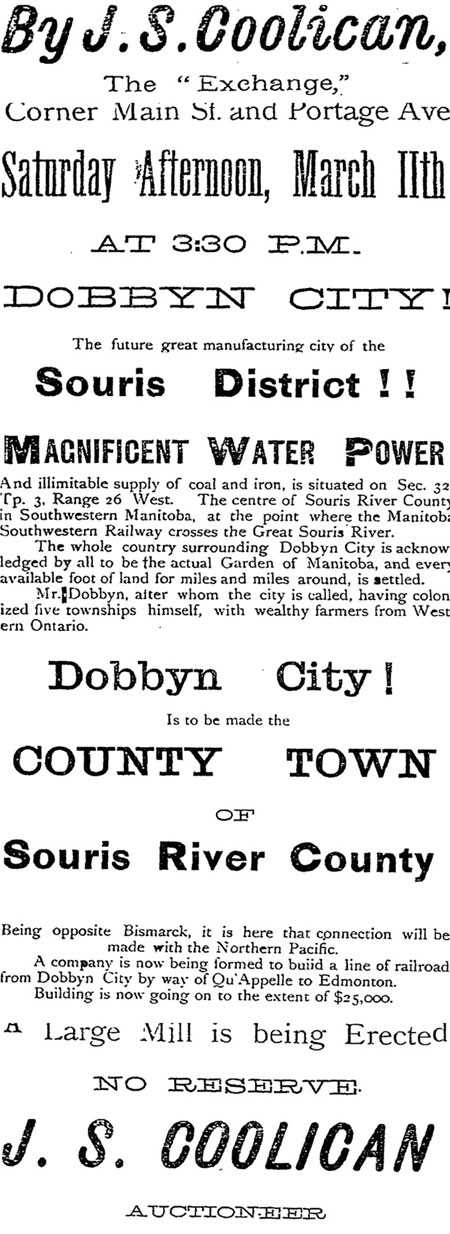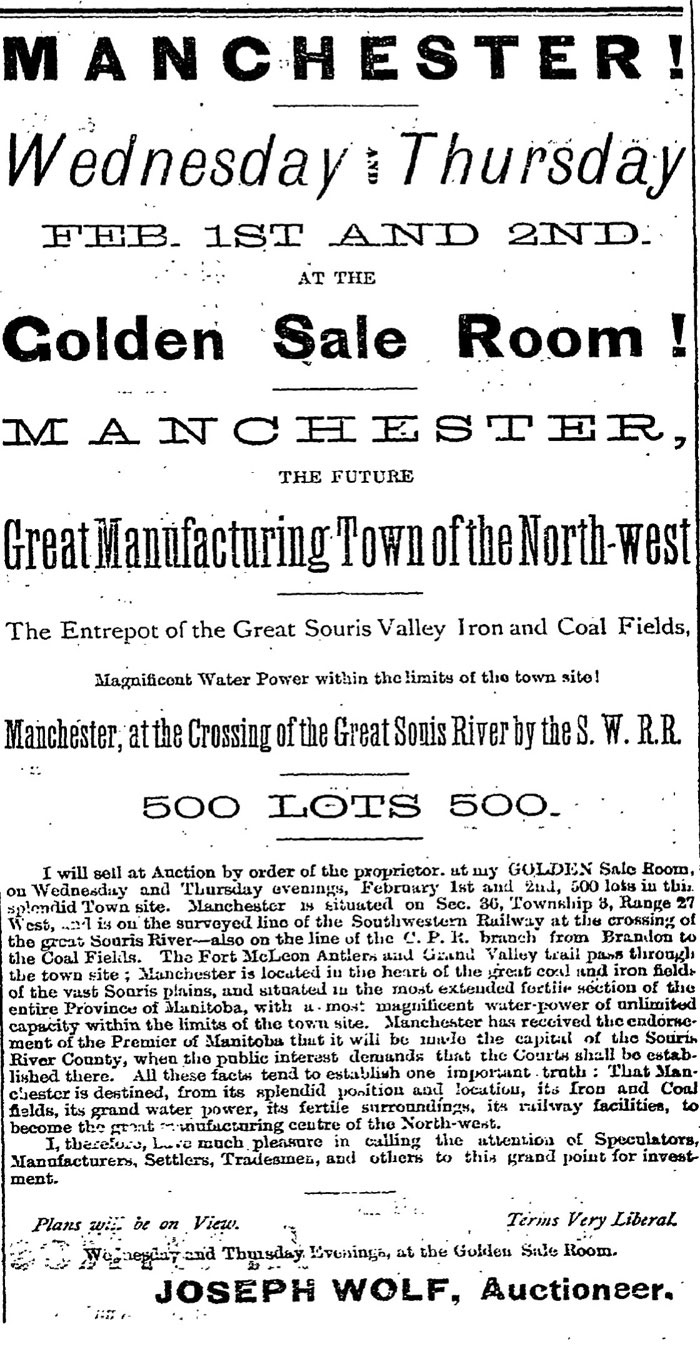|


13:
Becoming Melita

Before the railway
settled the matter as to where lasting towns would
be created, there were a few other ideas about where the commercial
centre of the region should be. That was especially true in the case of
Melita, where there were several enterprises competing for the prize so
to speak.
Not
one, but two speculative cities, Dobbyn City and Manchester, were
promoted near the location that eventually became Melita. Both were
advertised in the Winnipeg papers with extravagant ( fraudulent?)
claims to be the next big city of the west.
Through
all of this there was a community, modest though it was, that
actually did exist before Melita took its current form.
Menota
The
excellent museum at Waskada is home to Menota School, a restored
building moved to the site from several kilometres north of town.
The name has quite a bit of history attached.
The
name first appears in a February 5th edition of the Brandon Sun
where a contribution entitled “Menota, Man – Grand Rally of Farmers”
opens with this bit of information:
Notices
were posted beginning of this week, calling a meeting of
farmers at Dobbyn City, on Thursday, January 25th, for the purpose of
discussing the farmers’ grievances and forming a branch union. The
settlers heartily responded and about fifty farmers went at the time
appointed: but as Dobbyn City does not contain a building that has a
roof, it was found necessary to hold the meeting here.”
Along
with the wry dig at speculative cities like Dobbyn City, that
never did become towns, there is quite a bit of information in those
two sentences. First the farmers in all parts of southern Manitoba met
often in the early 1880’s to discuss grievances, bitch about the CPR,
and demand a bit of respect. Farmers’ unions were widely discussed,
proposed, and even created. And the fact that such a meeting was held
in Menota tells you that in a time when very few villages (with
buildings featuring a roof) existed, it had such a building.
Mr.
Livingston is widely known in the region as a Melita pioneer, but
as of 1884 Melita wasn’t appearing in the news.
As
of 1883, E.P. Snider had a post office and he and F.B. Warren
operated a store on a location a few kilometres east of where Melita
was later created. That about ended it’s growth spurt, but as a stop on
the southwestern postal route it served its purpose for a short while
until towns Like Melita and Waskada appeared.
As
was the pattern across rural Manitoba, no notice was taken when the
store closed and Menota ceased to be. Menota School was opened in 1887
a bit to the east in the RM of Brenda.
Dobbyn
City
John
Dobbyn, a homesteader near where Melita would later be located,
had selected land near the Souris River where there was the general
belief that a railway line would soon pass. In the spirit of the times,
Mr. Dobbyn had “Dobbyn City” surveyed and marketed.
It
was the region’s most representative example of the paper city. It
was just plausible enough to be sold with conviction, but the claims
wouldn’t pass today’s truth-in-advertising laws. Look through the ad
and see if you can separate the blatant lies from the mere wishful
thinking.
 Winnipeg
Daily Sun, March 9, 1882
Winnipeg
Daily Sun, March 9, 1882
Apparently
the ads worked… for a while. In March of 1882, The
Winnipeg Daily Sun reported the sale of 80 lots at an average of $30
each. How much, if any, of that money made its way into Mr. Dobbyn’s
hands, no on knows.
The
railway did eventually come in 1890, but Dobbyn City was long
forgotten and the river was crossed about a mile further
downstream. Mr. Dobbyn had long since focused on his farm, and
became a leading citizen of the new town of Melita.
Manchester
to Melita
Today,
of course, Melita is the largest town in the region.
However, this was not always the case and in the early days of
settlement it was not clear which service centres would thrive and
flourish into important centers and which ones would not.
In
1881, homesteader Dr. Sinclair had a quarter section of his land on
the west side of the Souris River surveyed as a townsite. The plan of
subdivision was registered with the Souris River Registry office in
March of 1882 and lots were sold to buyers as far away as Winnipeg. In
1883 R. M. Graham started a store, which was quickly followed by
another one, a blacksmith shop, an implement agency and a public school.
The problem was the name
they had chosen, “Manchester”. It was already
taken, so when, in 1884 when the townsfolk put together a petition to
open a post office, they were informed that Manchester had already been
adopted by a settlement in Ontario. They sent out a list of names for
the townsfolk to choose from, none of which were to their liking.
Local
citizens decided to meet after church the next Sunday to settle
on a name. It just so happened that the Sunday School reading that day
had been chapters 26 to 28 of Acts which describes the account of the
apostle Paul's shipwreck on the island of Melita (now called Malta).
Everyone agreed that the post office (and consequently the town itself)
should be called Melita after this Bible story. The postal department
agreed and the name was made official.
And
so the town was born, and as usual the business owners and
residents were content to move a kilometere or so east to be alongside
the new rail line when it arrived.
Before
the first train whistle sounded, Mr. G.L. Dodds had moved his
Hardware & General Store to the site of the new town and virtually
everyone followed.
 Winnipeg
Daily Sun, Jan. 31, 1882
Winnipeg
Daily Sun, Jan. 31, 1882
Buildings
were moved from the previous location just across the tracks
or built quickly from readily materials readily available via the new
rail line. Many of these building were substantial, but few survive
today. Within a few years they were supplanted and replaced by more
ambitious structures such as the Northern Bank, the I.O.O.F Hall and
the Crerar Law Office; all of which continue to grace the Main Street.
It was in that period that many fine homes were erected, of both frame
and brick construction, some near the core area, but others on the
perimeter. Owned by community leaders with names like Dobbyn, Duncan
and Holden, several of these buildings have been well cared for and
survive intact.
By
1892 numerous business blocks lined Main and Front Streets. An
interesting item from an 1891 edition of the Melita Enterprise states
that: “Most of the houses brought into Melita this year have found
ready sale.”
Blacksmith
James Duncan was one of many who had started a business in
the Manchester location, then moved it when the CPR placed their
station about two kilometres east of the well-established village.
(Photo - Archives of Manitoba)
Sources
Bridging
Brenda (Vol 1&2), Brenda History Committee, 1990
Melita:
Our First Century (Town of Melita and Municipality of
Arthur), Melita - Arthur History Committee
Sourisford:
Sourisford and Area from 1879, The Sourisford History
Committee


|
 |
 |
|
|